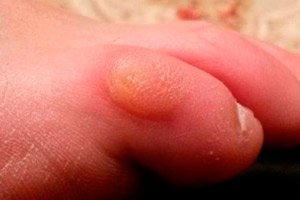
All iLive content is medically reviewed or fact checked to ensure as much factual accuracy as possible.
We have strict sourcing guidelines and only link to reputable media sites, academic research institutions and, whenever possible, medically peer reviewed studies. Note that the numbers in parentheses ([1], [2], etc.) are clickable links to these studies.
If you feel that any of our content is inaccurate, out-of-date, or otherwise questionable, please select it and press Ctrl + Enter.
Painful dry callus: what are the causes and what to do?
Medical expert of the article
Last reviewed: 12.07.2025

Doctors very often encounter complaints about a dry callus on the foot that hurts when walking, and they draw patients' attention to problems that could have been solved in a timely manner and painful symptoms could have been avoided.
Causes dry callus pain
The causes of dry calluses, as well as their symptoms, are discussed in detail in the publication Calluses and corns
Risk factors
And the main risk factors for the occurrence of painful sensations are the lack of timely treatment of dry calluses or corns. Many continue to wear narrow, uncomfortable shoes, prefer high heels (to the detriment of foot health), and in the presence of flat feet or age-related foot deformities, do not use such a simple and effective remedy as corrective orthopedic insoles and insoles. [ 1 ]
The progression of keratinization of skin areas on the sole is not so much a cosmetic problem as a medical one, although dry skin is often treated with cosmetics. Therefore, an unsuccessful attempt to remove a dry callus in a pedicure salon can lead to the development of inflammation, when redness, swelling of the soft tissues of the foot, and the formation of a necrotic focus with the release of serous-purulent exudate join the pain. [ 2 ]
Therefore, when, for example, a dry callus on the little finger, big toe or ball of the foot hurts, you should not contact a pedicure specialist, but an orthopedist, or better yet, a podiatrist.
Pathogenesis
The skin of the foot, including the sole, has many pain receptors (nociceptors). And the pathogenesis of pain in the sole is that the constant mechanical pressure of the keratin core of the callus on the underlying tissues affects the skin pain receptors and irritates them. In response to this irritation, a nerve signal is generated, first coming along the axon to the spinal cord (to the area of its posterior horn), and then to the brain - along the spinothalamic tract. As a result, a sensation of pain occurs. [ 3 ]
Complications and consequences
The pain that a dry callus can cause anywhere on the feet can be simply unbearable and prevent you from moving normally.
Such a callus may bleed, since its deeply embedded core can damage skin capillaries.
Diagnostics dry callus pain
In this case, the diagnosis is based on the patient's complaints and examination of the feet.
In doubtful cases, differential diagnosis using dermatoscopy is performed to identify other causes of pain, in particular, flat feet, plantar warts, plantar fasciitis (heel spurs), deforming arthritis of the joints, neuroma of the foot, age-related metatarsalgia, palmar-plantar hyperkeratosis and keratoderma.
Who to contact?
Treatment dry callus pain
What to do when a dry callus hurts? Ointments belonging to the group of non-steroidal anti-inflammatory drugs containing sodium diclofenac, as well as ointments with a reflex-distracting effect with menthol, camphor or capsaicin can relieve pain for some time.
For example, Bom-Benge (Ben-Gay) ointments with methyl salicylate and menthol or Doloxen Fast (which, in addition to methyl salicylate and menthol, contains camphor and turpentine oil), which is recommended to be rubbed into a large area two or three times a day.
But these medications for external use are a temporary measure, and to solve the problem you need to use products to remove dry calluses. First of all, products (ointments) with salicylic acid are used, for example, Hemozol.
Also used:
- Ointments for corns
- Ointments and creams for corns
- Creams for corns
- Plasters for dry calluses on toes (Salipod, Urgocor, Compid)
Traditional treatment – with a detailed description of the most popular methods – is given in the material – Core callus: causes of appearance, structure, treatment
Herbal treatments can be used: hot foot baths to steam calluses with a decoction of chamomile, sage, birch leaf, willow bark, licorice root or burdock, etc.
In advanced cases or when it is impossible to remove a dry callus with medication, surgical treatment is performed, which involves its removal by electrocoagulation, laser cauterization or cryodestruction (freezing) with liquid nitrogen.
Prevention
The main thing in preventing the appearance of core dry calluses and corns is to wear comfortable shoes that do not squeeze the foot; women should not wear shoes with very high heels (because of them, the load on the anatomical structures of the plantar part of the foot is distributed incorrectly); wear shoes with a sufficiently thick sole.
It is also important to combat excess weight, wear special insoles for flat feet, and prevent the skin on the soles of the feet from drying out.
Forecast
Dry calluses can be removed, but to avoid recurrence, you should carefully care for your feet and wear suitable shoes.

